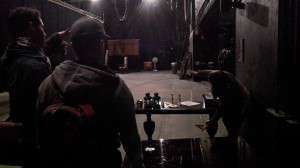by Ariel Mitchell, dramaturg
The last song in Gone Missing, “Stars,” discusses how when you lose something all that you have left is the memory of what once was, like that thing never existed.
Last semester, our media team broke down the script, choosing moments to mediate in both Gone Missing and The Cleverest Thief. “Stars” is one of these chosen moments. As a group, they decided to project a video in the background of a table crowded with objects. As the song, progressed the objects would disappear, leaving only the memory behind.
Simple right? It would seem so, but it is incredible how much work goes into one little clip.
The first thing that must be done is to set the specifics. What is the setting? Where should the table be in that setting? What kind of table is it? How big should it be? Will it look good on camera? What kind of objects do we want/need? How many? How crowded should it look?
The day before shooting the director, production designer, props mistress, and film crew met in the prop shop to check out some of the options for table and objects.

We decided we wanted the table to be in a nondescript location. We’d accomplish this by focusing on the table top itself.

We also decided we wanted the table littered with objects with no space separating one from the other, like an ISPY book.

We decided we wanted the objects to be a mix of things that our characters talk about and random things that could be lost.

The next day the crew met in Studio A to film. They started setting up at 3pm, began shooting at 5, and finished at around 7. Not bad for a 3 minute moment!

